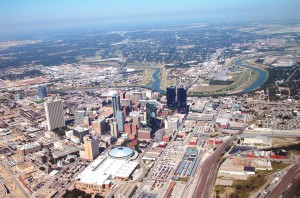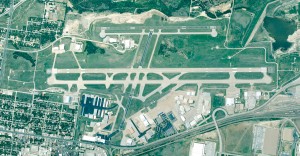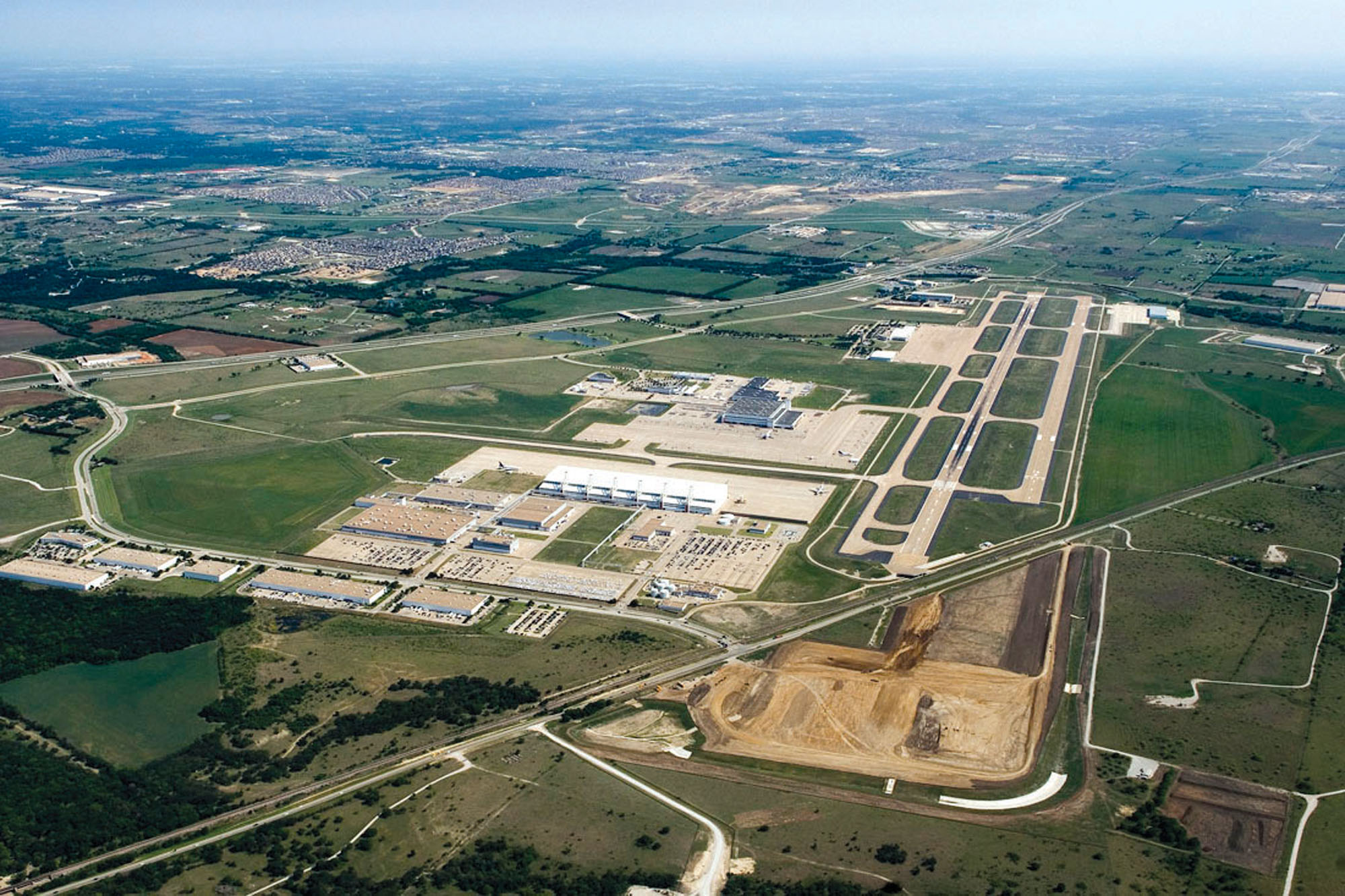
Fort Worth Alliance Airport offers direct taxiway access to nearby corporate residents in Alliance Center.
Fort Worth offers a choice when it comes to flying into their city. The city’s Department of Aviation has developed an airport system comprised of three general aviation reliever airports: Fort Worth Alliance Airport (AFW), Fort Worth Meacham International Airport (FTW) and Fort Worth Spinks Airport (FWS). One of the challenges faced by the Fort Worth Airport System is that each of the three airports serves an inherently different market.
“The City of Fort Worth has three of the best general aviation reliever airports in the state of Texas,” states Mike Feeley, the city’s airport systems director. “Given their convenient location to the commercial corridor and the heart of “Cowtown,” these airports are able to provide the citizens of Fort Worth with access to all aspects of the aviation industry, from flight training to large aircraft maintenance and repair.”
In recent years, significant capital improvements have been completed on each of the airports, both through private sector development as well as Federal Aviation Administration funded airport infrastructure upgrades. Fort Worth, with the FAA and the Texas Department of Transportation, has strategically planned these improvements to ensure that citizens are provided with the best airport from which to base their aircraft and operate their aviation-related businesses. The Airport Systems Plan, expected to be completed in the fall of 2006, will clearly identify each airport’s role so that the airports can be further developed to serve their respective market, where they will complement each other.
Fort Worth Alliance Airport
Alliance Air Services, a Hillwood Corporation affiliate, manages Fort Worth Alliance Airport on behalf of Fort Worth. The airport currently serves the heavy maintenance and cargo operations of American Airlines and Federal Express Corporation as well as being a home for Bell Helicopter and the Drug Enforcement Agency. Alliance becomes a destination for more than 400 aircraft during events at the Texas Motor Speedway. Since its inception in 1988, Alliance has completed $948,078,080 worth of improvements on and around the airport.
Fort Worth has completed significant infrastructure upgrades to facilitate the success of Alliance operations. The runway extension project has received more than 43 million dollars worth of work to date. This addition will allow for cargo-laden aircraft to fly nonstop international flights from Alliance. The full scope of the project includes the relocation of the BNSF rail and FM-156, in order to initially extend both runways from 9,000 to 11,000 feet, and the design for the ultimate length of 13,000 feet. The total estimated project cost is $154 million, with completion expected in approximately five years.
In addition to the runway extension project, Fort Worth has completed the development of a $14 million cargo handling apron and associated taxiway to help facilitate additional growth on the airport’s west side. The apron has the ability to handle four cargo laden 747s at the same time. The Hillwood Corporation has developed a $5.8 million spec building adjacent to the apron and is currently seeking a customer to establish additional cargo activity at the airport.
Through its partnership with the Hillwood Corporation, Fort Worth has realized untold economic stimuli from Alliance associated with on and off airport development as well as the creation of a significant number of new jobs for the city.
“Alliance Airport has served as a catalyst for economic development in north Fort Worth and has become the centerpiece of one of the most successful inland ports in the country,” said Tim Ward, president of Alliance Air Services.

Downtown Fort Worth and the Fort Worth Convention Center span 14 blocks, including the Will Rogers Memorial Center. The Convention Center has been undergoing major expansion, including additional meeting space, ballrooms and exhibit space.
Meacham International Airport
Meacham International Airport, established in 1925 as Fort Worth Municipal Airport, is the oldest airport in Fort Worth. Meacham has a very impressive placeholder as it relates to our national aviation history. From the mid-1920s, when the USS Shenandoah operated at Meacham Airport, to present day operations, the airport has accomplished some very impressive milestones. Today Meacham has developed into one of the leading airports for general aviation, corporate and flight training activities. The airport has approximately 76,000 annual operations with 62 executive jets calling Meacham home, with expectations that number will grow to more than 74 in the near future. Meacham is also home to four public fixed based operators and five flight schools. Fort Worth is constantly entertaining development proposals to help best position the airport. Most recently, private developers completed more than $18 million worth of improvements, including several large aviation facilities.

Fort Worth Meacham International Airport, at an elevation of 710 feet and with three runways, is located minutes from downtown Fort Worth and the historic Fort Worth stockyards.
Due to the age of the infrastructure of this older airport, Fort Worth has programmed upgrades to operating surfaces that include a $15 million runway repair project to begin construction in 2006. The project includes repairing the runway surface, filling in the safety areas off both ends of Runway 16/34, adding shoulders to the runway and building a new tenant ramp area. This will be the first major improvement on the airport since the development of the full length parallel taxiway on the east side. As a good neighbor, Fort Worth has also completed four phases of a five-phase noise mitigation program. When complete, the program will have included more than $17 million worth of property acquisitions that will help protect the airport and surrounding neighborhoods from noise-related encroachment issues.
Fort Worth Spinks Airport
Fort Worth Spinks Airport, the newest airport in the system, was opened in the late 1980s and was named after Pappy Spinks, who operated numerous aviation-related businesses.
Over the last three years, a major growth spurt has occurred at Spinks Airport, indicating the great potential it has as one of the Metroplex’s most important and upcoming general aviation airports. The airport has exploded with $6.5 million in private sector developments, including 18 new corporate jet hangars, 37 new T-hangars, and fixed base operator Harrison Aviation’s new corporate hangar and state-of-the-art executive terminal. Proposed corporate hangars and office facilities are planned to start construction later this year. The aircraft base has increased from 164 aircraft in 2004 to a current count of 215 aircraft from single-engine, homebuilt aircraft to larger corporate aircraft such as Lear and Citation jets. These based aircraft as well as the transient traffic make up the traffic count recorded at more than 82,000 operations ending in 2005, a robust improvement from just over 60,000 operations in 2003.
In cooperation with TxDOT, Fort Worth has funded and completed more than $6 million in capital improvement projects in the last three years. This includes taxiway lighting, a 75,000-square-foot aircraft parking apron expansion, automated weather observation system, air traffic control tower, and a runway/taxiway overlay increasing the weight and size of aircraft the airport can accommodate. The new ATC tower, about 80 percent complete, stands over 60 feet tall and can be seen from Interstate 35W. The new tower will increase safety measures and promote corporate traffic as well as being a catalyst for new growth potential for the airport.

Spinks Airport, located 14 miles south of Fort Worth on 822 acres, offers the greatest potential for future growth.
The future is bright for Spinks, with an estimated $1.5 million in new projects planned for 2007. Located just 12 miles from downtown Fort Worth, Spinks is ideally located to accommodate business executives from all over the country.
The next steps for the future of aviation in Fort Worth are currently being evaluated in the Airport Systems Plan. In connection with the TxDOT, Fort Worth has retained the services of Wilbur Smith and Associates to help determine the best use for each airport, which will allow the city to strategically promote and develop each airport in a way that will complement their respective market.
Mike Feeley extends a welcome on behalf of the city.
“If you have not flown to Fort Worth lately, we welcome you to take a trip to ‘Cowtown’ and visit any of our three facilities located near the heart of downtown Fort Worth,” he wholeheartedly says.
For more information about the Fort Worth airports or the Fort Worth Airport System, call 817-871-5400 or visit [http://www.fortworthgov.org/aviation].











